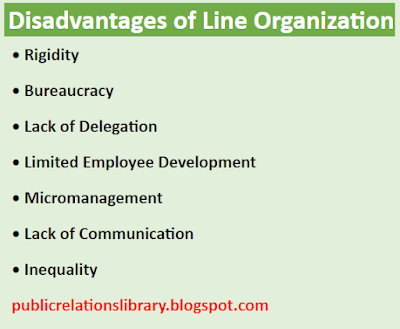The line organization is a traditional structure for
businesses where the authority and responsibility for tasks and decision-making
is arranged in a hierarchical, top-down manner. However, despite its widespread
use, the line organization is not without its drawbacks. The following are some
of the disadvantages of line organization:

- Rigidity:
Line organizations tend to be inflexible, with strict policies and
procedures in place, which can make it difficult to respond to changes in
the market or new business opportunities.
- Bureaucracy:
The hierarchical structure of line organizations can create a bureaucratic
culture, which can lead to slow decision-making, lack of creativity and
innovation, and a lack of motivation among employees.
- Lack
of Delegation: Line organizations often suffer from a lack of delegation,
as decisions are made at the top, and tasks are completed by lower-level
employees with limited autonomy.
- Limited
Employee Development: Line organizations may limit employee development,
as there is limited opportunity for employees to take on new tasks or
roles and gain experience in different areas of the business.
- Micromanagement:
Line organizations can lead to micromanagement, as decisions are made at
the top, and employees at lower levels are not given the autonomy to make
decisions on their own.
- Lack
of Communication: Line organizations often lack effective communication,
as information flows only from the top down, and there is limited
opportunity for employees to contribute ideas or provide feedback.
- Inequality:
Line organizations can create an unequal distribution of power, resources,
and decision-making authority, which can lead to dissatisfaction among
employees and a lack of motivation.
In conclusion, while line organizations have been widely
used, they have a number of disadvantages, including rigidity, bureaucracy,
lack of delegation, limited employee development, micromanagement, lack of
communication, and inequality. These disadvantages must be taken into consideration
when deciding on an organizational structure for a business.